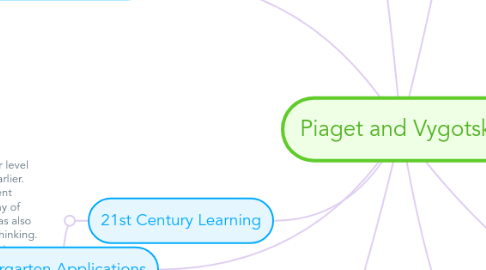Piaget and Vygotsky
by Tiana Buford

1. According to The Encyclopedia of Children's Health, cognitive development is the construction of thought processes including remembering, problem solving, and decision making from childhood through adolescence to adulthood.
2. 21st Century Learning
2.1. Children are expected to use higher level thinking a lot more now and a lot earlier. Teachers also are expected to present materials to their students in an array of many different ways. Technology has also played a key role in this high level thinking. Children and teachers are now able to use computers and apps to reinforce all that they learn in the classrooms
3. Piaget's Theories
3.1. Children are active motivated learners
3.2. Children construct knowledge from experience
3.3. Children learn through assimilation and accommodation
3.4. Equilibration promotes progression toward increasingly complex thought
3.5. Interaction with physical and social environments is essential
3.6. Children think in qualitatively different ways at different ages
4. Cognitive Development
4.1. My perspective of cognitive development is the way the children process the world around them. From the moment children are born they are developing the language, culture, and social aspects around them. Cognitive development not only changes with age but it also changes with your environment.
5. Prekindergarten Applications
5.1. Zone of proximal is used daily in my classroom with the usage of centers. Each week the children are able to choose between centers, even though the centers are the same the activities within the centers change. The children are able to use these different activities to think higher each week. As the weeks go on, I begin to notice that the children are not only learning, but are able to have those higher level thinking conversations with myself as well as their peers.
5.2. One theory that Piaget studies was that the interaction with physical and social environments is essential to the development of children. One way that we do this at my school is by the usage of sensory tables, as well as allowing the children to have 40 mins of outdoor classroom each week. With the usage of outdoor classroom, children are able to gain new knowledge and information using the nature around them, thus giving them a physical interaction with not only the indoor classroom environment, but the outdoor as well.
6. Comparisons
6.1. Both Piaget and Vygotsky believed that children construct their own knowledge through their experiences. They also both believed that children begin to think differently in every stage of their developmental growth.
7. Learning impacts development.
8. Vygotsky's Theories
8.1. Children construct knowledge.
8.2. Learning can lead development.
8.3. Development can not be separated from its social context.
8.4. Language plays a central role in mental development.
8.5. New node
8.6. Zone of proximal development
9. When the teacher structures the activity differently, the child is able to perform the task at a higher level.


